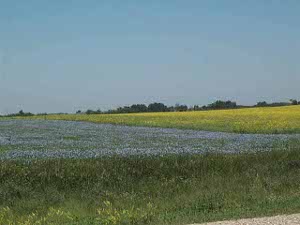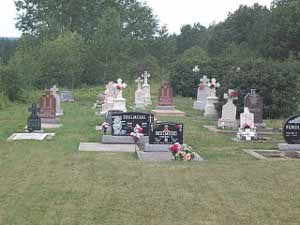 Flax and canola
Flax and canola
We followed the northern route across central Canada, through Dauphin and The Pas and Flin Flon to Prince Albert and Meadow Lake and then to Edmonton. Although we did have some interesting wildlife sightings, this route featured hours of monotonous forests and lakes punctuated by tiny wilderness settlements, fishing camps, a few interesting towns, and one small city.
 Flax and canola
Flax and canola
We were wrong about clover fields. The acres of brilliant flowering fields, alternately yellow and blue, are instead canola and flax, which have become popular cash crops in the far northern farmlands. (Canola used to be called rape, but euphemism has set in.) Elsewhere there's hay and more hay; not surprising that the former North American prairie should be good for growing grasses.
There were more signs for U-Pick saskatoons than for those picked by the farmer; we decided that was probably because the little thorns make the berries no fun to pick! Anyway, they're not ripe yet, so we didn't get to experiment.
We were right on time, though, for the Swan Lake rodeo. The parade was just beginning as we approached town... and were vigorously pointed by policemen onto the detour. We thought it odd that the town wasn't trying to trap the passing tourists but zipped them through a bypass and out the other end of town without so much as a gas station or ice cream stand. So we can't tell you much about the rodeo, except the young man in the next town, 50 miles north, said the bull riding isn't much -- they only stay on for a minute or so. How about that, Dave?
 Ukrainian cemetery
Ukrainian cemetery
The woman running the gas station at Cowan was assembling braids of sweetgrass, which was gathered by Canadian First Nations people and will be trucked for sale to Native Americans in the U. S. for use in ceremonies.
Along the highway were small Ukrainian cemeteries; in a couple of cases the Roman Catholic Ukrainian cemetery was next to, but fenced off from, the Greek Catholic Ukrainian cemetery.
We're far enough north, but at the wrong time of year for northern lights, although there was a surprise appearance one night earlier this month. Anyway, we're generally sound asleep at the time the northern lights might be visible!
Riding Mountain, a well publicized national park with lots of campgrounds, lakes, and trails, is not a mountain but a pre-Cambrian shield upthrust ridge, which just means it's higher and rockier than the surrounding forest. Other mountains in Manitoba seem even smaller; from one point on the highway we could look down on the top of Duck Mountain. Of course the further north you go, the more you are travelling down hill, as all the water drains north into Hudson Bay.
There are a few little towns, just dots on the map, which have a couple of blocks of Main Street and then back into the woods. You can tell the important towns: they're the ones with Wal-Marts. When we checked into the motel in The Pas the clerk asked, "Why are you here?" The next morning we drove  Prosperous farm
up and down most of the streets of town, taking in the junior college, two parks, two big homes (meaning 3 BR, 2 B) and a whole lot of smaller ones (2 BR, 1 B), a tiny indoor mall consisting of four stores on the street front, and the Via Rail station, from which you can embark on a long railroad trip to Churchill on Hudson Bay. We had toyed with the idea, but the best time to visit Churchill is in October to see polar bears.
Prosperous farm
up and down most of the streets of town, taking in the junior college, two parks, two big homes (meaning 3 BR, 2 B) and a whole lot of smaller ones (2 BR, 1 B), a tiny indoor mall consisting of four stores on the street front, and the Via Rail station, from which you can embark on a long railroad trip to Churchill on Hudson Bay. We had toyed with the idea, but the best time to visit Churchill is in October to see polar bears.
Light rain showers were with us most of the day between The Pas and Prince Albert. The temp was down to 14, which we thought was nice.
We were seeing more beaver lodges in the lakes, which made us believe there was wildlife to be spotted. There were hawks, a few deer, and a herd of domesticated bison. We saw a couple of groups of white pelicans; they raise their young on Canadian lakes before returning to Florida for the winter. Unexpectedly, we came upon a caribou standing squarely in the middle of the road, licking off the salt with so much concentration that we approached quite closely before (s)he bounded off. Later we stopped to photograph the reflection off a forest lake. Then we heard an eerie, melancholy cry, which we traced to a family of loons swimming around on the lake. A parent would dive under and pull up a piece of delicious stringy lake grass, then drop it on the water for a youngster to capture. We got out the binoculars to view the necklace on each parent, and heard all of the different loon calls described in our Sibley guide. It was a magical event. The Canadian national bird, and the name of their dollar coin - the loonie.
The land around Flin Flon is radically different from the forest and lake scenery. It consists of rocky hills - so rocky that nothing grows, just mounds of rock outcroppings. All those rocks must have got the geologists excited, because the mining operation is enormous, and the power plant to provide enough electricity for the mining seems even bigger. The smoke stack reached up into heaven. The houses are planted between the bare rocks, and the streets wind around like serpents.
As for the name of the town, we quote from the sign: "Flin Flon is named after Josiah Flintabbatey Flonatin, an adventurer in "The Sunless City", a novel by E. Preston-Muddock. In 1914, a copy was found in the wilderness of northern Manitoba by a party of prospectors. A year later, these men working claims near the present site of Flin Flon, came upon a conical hole having rich showing of gold. Tom Creighton, recalling the adventures of Flintabbatey  Flin Flon
Flonatin who escaped from an underground lake through a large gold studded hole in the earth's crust, suggested the claims be called Flin Flon. The others agreed and that is how Flin Flon got its name." The adjacent statue was designed by the cartoonist Al Capp.
Flin Flon
Flonatin who escaped from an underground lake through a large gold studded hole in the earth's crust, suggested the claims be called Flin Flon. The others agreed and that is how Flin Flon got its name." The adjacent statue was designed by the cartoonist Al Capp.
About 25 miles of highway was not paved, but the locals drove 55 miles an hour anyway! Just outside of Prince Albert we emerged from the forest into farmland; the Great Plains stretch much further north in Saskatchewan than Manitoba.
The Prince Albert tourist brochure shows a photo of a substantial brick house, called The Keyhold Castle, home of local hero Sam McLeod, but it didn't give an address or mark it on the map, and despite a thorough tour through town, past four parks, two schools, the wide, brown Saskatchewan River, and the house of former prime minister Diefenbaker, we never did find out about Sam McLeod or see his house! We did spot a nifty new McDonalds with a two-story rounded corner and lots of windows, though.
In northwest Saskatchewan we found patches of farm and ranch land separated by miles of forests. We appreciated a huge stand of birches, which are the official trees of Saskatchewan. In contrast to much of the coniferous forest we've been seeing, the birches looked strong and healthy. In one provincial park the underbrush had been burned, and lots of the coniferous trees, too, or so it seemed, all as part of the Dwarf Mistletoe Control Program, according to the signs. We couldn't make out anything that looked like mistletoe, dwarf or not. Maybe the Program was successful.
Not much to report in the wildlife sighting, though -- just a lonely coyote, and lots of kilometers between gas pumps. We stopped in Meadow Lake for gas, lunch, the chuckwagon races, and a Super 8 motel which had paintings of the southwestern desert on the walls. And of course the friendly Canadians.
Canadians from Manitoba and Saskatchewan are envious of Alberta. It has all the money, they say, and all the attention from Ottawa (except, of course, for all the attention paid to Ontario). Alberta, say the Canadians, is rich. We did see the occasional oil or gas well, but we met a farmer at lunch in a Chinese restaurant who put us straight. He had worked for years in the Saudi oil fields, met a school teacher, and retired to a gentleman's farm. He said the Canadians only get surface rights for the wells; the rest of the royalties go to the government.
But the farming business is subject to the whims of nature, and the Alberta fields appeared patchy and brown. Despite the thousands of lakes, most  World's Tallest Mushroom
of these fields are not irrigated, and the low rainfall this summer caused many farmers to lose their crops. We were interested in how many Alberta farmers had shifted to raising game for hunters. We think the game ranch business is sort of like the horse business -- it's economically viable only because there are lots of city folks with money to spend on recreation. We wonder whether it makes any difference to the hunter if the animal is raised on a game farm.
World's Tallest Mushroom
of these fields are not irrigated, and the low rainfall this summer caused many farmers to lose their crops. We were interested in how many Alberta farmers had shifted to raising game for hunters. We think the game ranch business is sort of like the horse business -- it's economically viable only because there are lots of city folks with money to spend on recreation. We wonder whether it makes any difference to the hunter if the animal is raised on a game farm.
The Lions Club has been busily supporting community parks and services. In Vilma, in the center of the Ukrainian settlement of Alberta, is the World's Tallest Mushroom, contributed by the local Lions Club. Signs invited travelers into town to view the statue, but the town isn't quite ready to receive them. Many of the stores on the short main street are undergoing repair and restoration, Project III (presumably to be finished next year). In the next town, civic pride announced itself in the form of the pumpkin truck.
It started to rain as we approached Edmonton; but the rain was too late to save many farmers' crops, said the paper. It was a welcome relief from the summer heat, though.
We took five easy days from Winnipeg to Edmonton across the northern edge of the settled country. It was relaxing and enjoyable, perhaps a little boring. We reflected on the fact that most Canadians live within 100 miles of the U. S. border, and on the fact that our "northern" route was really kind of southern.